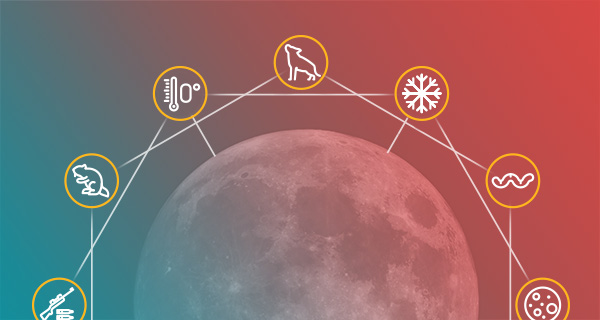Look to the Moon
If you follow astrology, you know how important the moon is. Astrology as many of us know it today, originated in ancient Greece around 2000 years ago; however, indigenous cultures of the Americas have been looking to the skies for much longer in order to draw inspiration and direction for their everyday lives. Each of the Full Moons of the year were given names by different tribal nations, including the Cherokee, Algonquians, Cree, and others. Most of the names that we use today come from the Algonquians who lived in the New England area just west of Lake Superior and were adopted by early colonists.
Indigenous peoples of the Americas often relied upon the moon to track the months of the year and named them for what was most important in their lives during specific times of the year. Since different nations had different routines, cultures, and wildlife, each moon has multiple names depending on the region.
Related: Guide to This Year’s Supermoons
Wolf Moon (January)
The Algonquians called January the “Wolf Moon” because wolves could be heard howling during this time of year. Wolves howled around this time to locate pack members, declare hunting territories, and to call themselves together to go out and hunt. In other regions, this moon is referred to as the Old Moon and the Great Spirit Moon.
Learn more about the meaning of the Wolf Moon.
Snow Moon (February)
February’s Snow Moon, also known to other tribes as the Bone Moon, Hunger Moon, or Storm Moon, was named for the time of year where cold weather was still lingering and hunting and gathering was less fruitful.
Learn more about the meaning of the Snow Moon.
Worm Moon (March)
The Worm Moon in March was named this because of the worms that could be seen on the ground in the area where the Algonquian tribe lived. In other regions it has also been called the Crow Moon and the Sap Moon because these begin to appear throughout this month as well.
Learn more about the meaning of the Worm Moon.
Pink Moon (April)
The Pink Moon was named, sadly not for the color the moon takes on, but for a particular flower that often blooms in the Eastern parts of the country. This flower is called moss phlox, or moss pink, and is usually one of the earliest of the spring flowers. In other regions, the moon is also referred to as the Sprouting Grass Moon, the Egg Moon, and the Fish Moon.
Learn more about the meaning of the Pink Moon.
Flower Moon (May)
When you remember the old saying, “April showers bring May flowers”, it’s no real surprise that the Algonquin tribe named this moon the Full Flower Moon. This moon is also referred to as Milk Moon, Corn Planting Moon, and Mother’s Moon in other regions of the country. May is a month of abundance and fertility after all.
Learn more about the meaning of the Flower Moon.
Strawberry Moon (June)
The Full Strawberry Moon was a signal to the Algonquin that it was time to start gathering ripened strawberries in the area. In other regions of the country this moon is known as the Rose Moon, the Honey Moon, the Hot Moon, and the Mead Moon.
Learn more about the meaning of the Strawberry Moon.
Buck Moon (July)
The July Full Moon was called the Buck Moon by many indigenous tribes because this was the time of year in which a buck’s antlers were growing to their full height. In some regions, this Full Moon was also called the Thunder Moon due to the excess of thunderstorms at this time of year.
Learn more about the meaning of the Buck Moon.
Sturgeon Moon (August)
The Full Sturgeon Moon gets its name from the abundance of sturgeon in the Great Lakes and Lake Champlain during the month of August. In other regions of the country, this Full Moon was called the Blueberry Moon, Wheat Cut Moon, Full Green Corn Moon, or the Moon When All Things Ripen.
Learn more about the meaning of the Sturgeon Moon.
Corn Moon (September)
The Full Corn Moon, also known as the Barley Moon in the Northeastern region of the United States, was named to signal the time for harvesting these crops. This moon is also known by the Lakota Tribe as the Moon When the Plums are Scarlet, Moon When the Deer Paw the Earth by the Omaha Tribe, and Moon When the Calves Grow Hair by the Sioux Tribe. This Full Moon is also sometimes known as the Harvest Moon, but only if it’s the Full Moon closest to the Fall Equinox, otherwise the October Full Moon will be called the Harvest Moon instead.
Learn more about the meaning of the Harvest Moon.
Hunter Moon (October)
Another moon that could easily be called the Harvest Moon depending on the when it falls in relation to the Fall Equinox, the Hunter’s Full Moon is one of the few on this list that was not named by a Native American tribe. Hunter’s Moon comes from an old English term that possibly dates back to the Anglo Saxons. Other names for this Full Moon are the Sanguine Moon and Blood Moon, while the Native Americans called it the Travel Moon and the Dying Grass Moon.
Learn more about the meaning of the Hunter Moon.
Beaver Moon (November)
The Beaver Full Moon got its name from the fact that November is when beavers start withdrawing into the dens they’ve taken so many months to build. It was an important time to note for colonists and Native Americans who were active in the fur trade in North America, which is probably why the name stuck. In other regions of the country, this Full Moon is called the Frost Moon, Freezing Moon, and Digging Moon.
Learn more about the meaning of the Beaver Moon.
Cold Moon (December)
The Full Cold Moon was named by the Mohawk Tribe to describe the freezing temperatures that much of the country experiences during the month of December. The Cree Tribe called this moon the Drift Clearing Moon, the Frost Exploding Trees Moon, and the Hoar Frost Moon. The Oglala Tribe called it the Moon of Popping Trees, the Cherokee Tribe called in the Snow Moon, and the Western Abenaki Tribe called it the Winter Maker Moon. The Mohican Tribe even had a name for the Full Moon when it rose around the Winter Solstice: the Long Night Moon.
A Cycle of Intention
As each month passes, and a lunar cycle begins, remember that each New Moon signals a chance for a new beginning and a time to set intentions. The Full Moon is the culmination of whatever intentions, hopes, and desires you dream and work for. Just as the indigenous tribes of the Americas used the moon cycle to track the passing of the seasons or specific yearly tasks that needed to be accomplished, we too can use the moon to help us accomplish our goals.




